To break free from zero allocation, the first step is often the hardest.
Written by: Coinbase
Translated by: Luffy, Foresight News
Web1.0 and Web2.0 transformed global data communication and social media, but the financial sector has lagged behind. Today, "Web3.0" is revolutionizing currency and finance through blockchain protocols. These protocols are evolving rapidly, and businesses are adopting them to stay competitive.
The development of disruptive technologies follows a predictable trajectory, but the time to adoption is shrinking rapidly. It took 75 years for the telephone to reach 100 million users, 30 years for the internet, and 16 years for mobile phones, while today's mobile applications can achieve mass adoption in just a few months. For instance, ChatGPT reached 100 million users in less than two months! Web2.0 platforms reduced transaction friction but centralized control, capturing most of the economic value and user data. Blockchain protocols address these shortcomings, allowing currency to flow freely on the internet, granting users ownership, and operating without intermediaries.
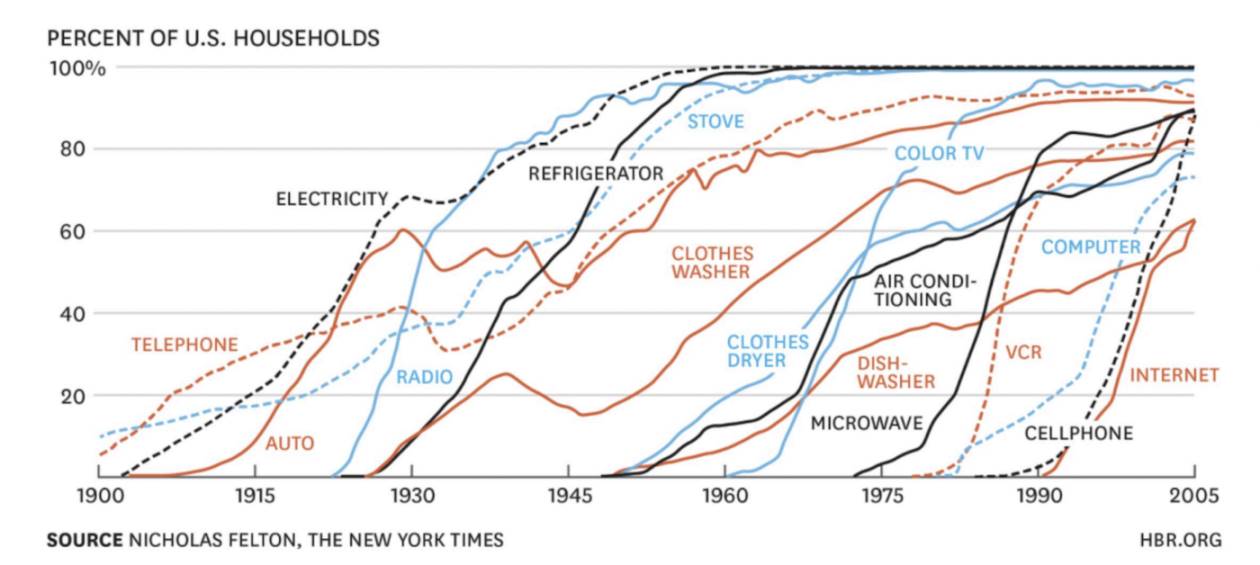
Currently, institutional adoption of blockchain is accelerating, laying the groundwork for consumer-level disruption of traditional Web2.0 platforms, and policymakers are taking notice. The GENIUS Act has now become law, regulating the issuance of stablecoins, which has strategic significance for the dollar's strong position globally. The CLARITY Act has passed the House, aiming to clarify the regulatory approach of the U.S. Commodity Futures Trading Commission (CFTC) and the U.S. Securities and Exchange Commission (SEC) towards cryptocurrencies. Importantly, both bills have bipartisan support. Finally, the SEC has just announced Project Crypto, a full committee initiative aimed at modernizing securities rules and regulations, fully integrating blockchain technology into U.S. financial markets. Crypto technology is rewriting history.
Three Major Trends: Platforms Face Disruption
Web2.0 platforms rely on centralization, limiting interoperability between different ecosystems. Blockchain protocols will break this situation, creating open, permissionless, and interoperable markets. Three major trends are driving this shift:
Bitcoin Protocol
Bitcoin has a fixed supply of 21 million coins and is a decentralized network secured by cryptography, with a market cap exceeding $2 trillion and hundreds of millions of users. Originally envisioned as peer-to-peer cash, Bitcoin has evolved into a store of value, favored by institutions like Coinbase (with 105 million users) and BlackRock (whose Bitcoin ETF quickly reached $80 billion in size), as well as multiple governments. Bitcoin's daily trading volume in spot and derivatives markets ranges from $70 to $100 billion, ensuring ample liquidity globally. Interoperability initiatives like "wrapped Bitcoin" on Ethereum enhance network effects, allowing Bitcoin to be utilized across thousands of third-party applications and networks. Thus, the Bitcoin economy is rapidly developing, driving demand for this scarce asset.
Stablecoin Applications
Stablecoins are on-chain tokenized fiat currencies, holding over $270 billion in assets across more than 175 million wallets. Although smaller in scale compared to traditional fiat currencies, stablecoin annual transaction volume is expected to approach $50 trillion by 2025, making it a true killer application in the crypto space.
Stablecoins are among the top 20 holders of U.S. Treasury securities. They are so efficient—faster and cheaper than fiat currency transfers—that the U.S. government has prioritized clarifying the regulation of stablecoin usage. As a result, platforms like PayPal and Visa, which are impacted, must adapt and actively embrace these technologies; they can no longer rely on oligopolistic control over the banking system.
The U.S. Treasury Secretary anticipates that by 2028, the asset size of stablecoins could exceed $2 trillion and handle 30% of global remittance transactions. It is expected that the stablecoin economy will bring billions in fee revenue to on-chain platforms like Coinbase.
Decentralized Finance (DeFi) Protocols
DeFi offers programmable asset management services, with hundreds of protocols locking approximately $140 billion in funds, providing round-the-clock trading, lending, and tokenization services. DeFi applications like AAVE and Morpho allow permissionless lending, while perpetual contracts on decentralized exchanges (DEXs) offer complex strategies like funding rate arbitrage.
BlackRock's BUIDL (BlackRock U.S. Dollar Institutional Digital Liquidity Fund) will disrupt and change asset management models, shifting power to on-chain distributors. A new wave of asset managers is emerging in these areas, while existing traditional platforms face survival challenges; those that do not adapt will be eliminated.
Bitcoin and stablecoins are nearing full regulatory clarity and mass adoption. In the coming years, DeFi is expected to achieve clearer regulation and improved scalability. Companies conducting on-chain business today will lead the next wave of innovation. These three trends will bring significant shifts in corporate growth and portfolio returns. Investors currently exposed to zero crypto assets should take note.
Breaking Free from Zero Allocation: A Portfolio Approach
Cryptocurrencies are still young; Bitcoin is only 16 years old, Ethereum is 10, and it wasn't until recently, with Ethereum's upgrade to a proof-of-stake consensus mechanism, that it developed into a highly powerful network. Stablecoins have just passed their 7th anniversary, and with the passage of the GENIUS Act, their regulation has become clearer.
But these technologies are entering a golden age, rapidly maturing as stablecoins integrate into banking, payments, automation, and AI agents.
Just as governments bring cryptocurrencies into the mainstream through prudent policy adjustments, institutional investors are also evaluating frameworks for incorporating crypto technology into their portfolios. This process has only just begun, and the first step is always the same: breaking free from zero crypto asset allocation.
Five Strategies to Break Free from Zero Allocation
To promote the adoption of cryptocurrencies in institutional portfolios, we evaluated five strategies that leverage portfolio analysis, capital market assumptions, and index approaches. The following three charts outline these strategies: Portfolio A) Bitcoin (BTC), B) Coinbase 50 Index (COIN50), C) Active Asset Management (ACTIVE), D) Store of Value Index (SOV), and E) Listed Crypto Stocks (MAG7), which aim to address diversification and risk-adjusted return issues in the traditional 60/40 stock-bond portfolio.
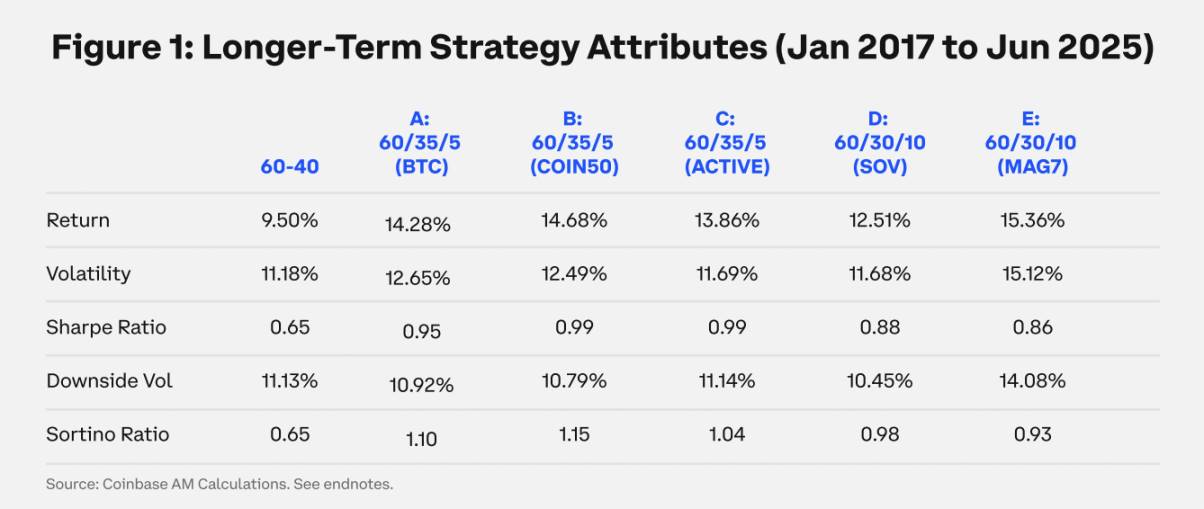
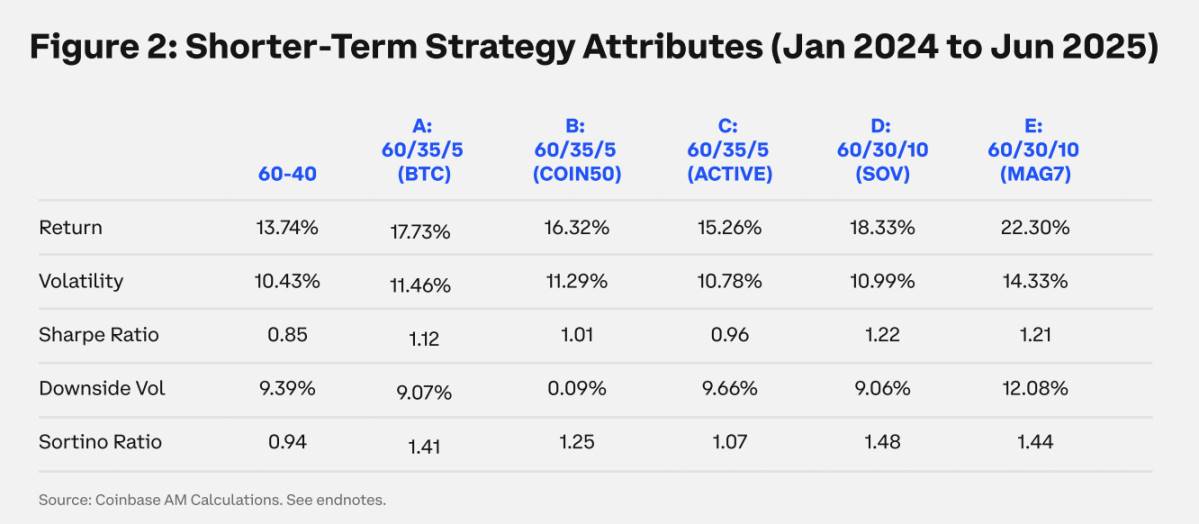
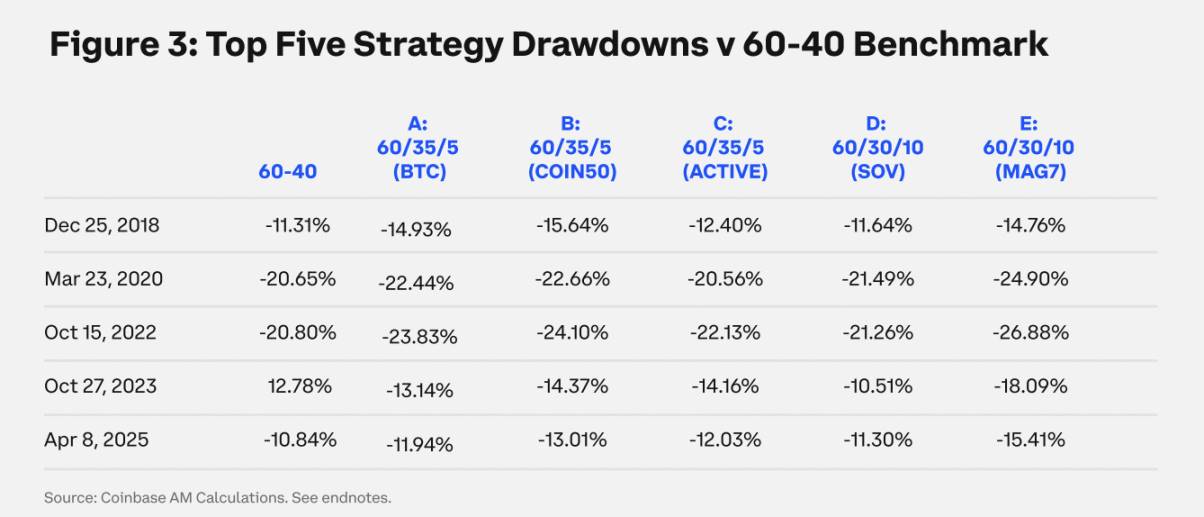
Portfolio A: Bitcoin (5% Allocation)
The simplest way to break free from zero allocation is to add Bitcoin to the portfolio. To simplify risk exposure, we consider a 5% allocation to Bitcoin. From January 2017 to June 2025, a 5% Bitcoin allocation significantly increased the portfolio's return. During this period, Bitcoin's compound annual growth rate (CAGR) was 73%, with an annualized volatility currently at 72% and trending downward. (Performance data can be found in Chart 1).
Even a modest 5% Bitcoin allocation (replacing bond allocation) can significantly improve portfolio performance compared to the 60/40 stock-bond benchmark strategy, adding nearly 500 basis points to annual portfolio performance while enhancing risk-adjusted returns and reducing downside volatility.
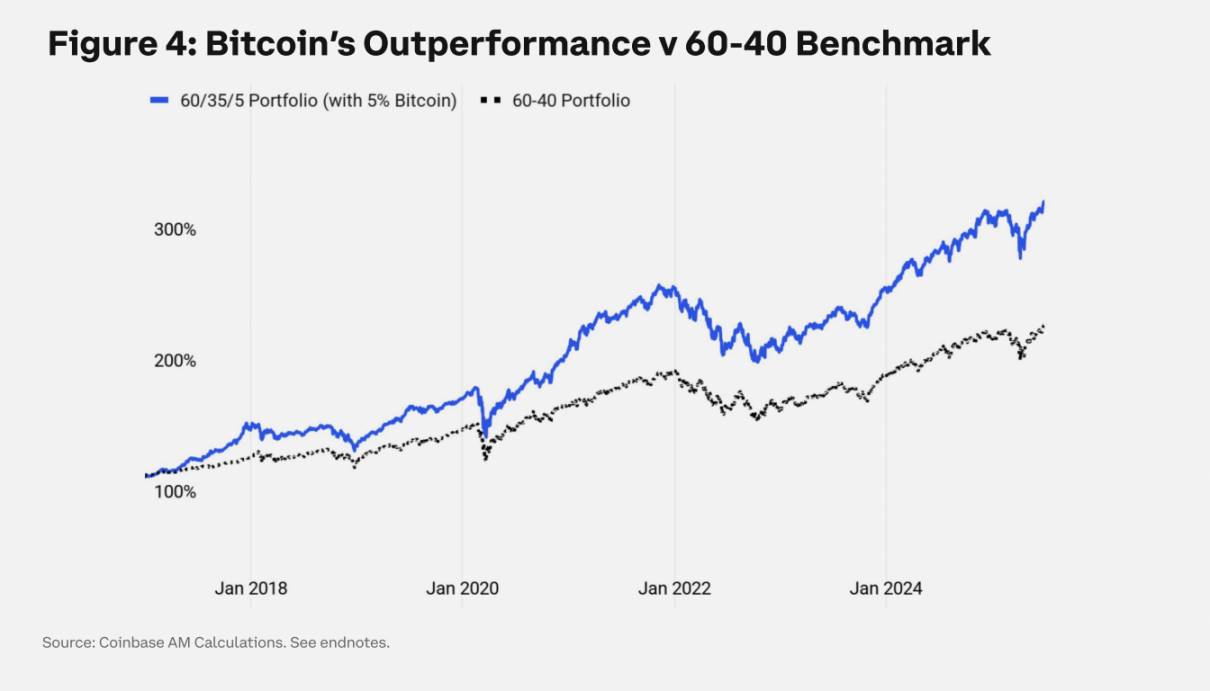
Given the rise in institutional adoption since the launch of Bitcoin exchange-traded products (ETPs) in 2024, it is necessary to analyze a shorter sample period separately. Not only do the overall results still hold, but the risk-adjusted returns are even stronger. The Sortino ratio (which measures excess return relative to downside volatility) increased by 34% with the rise in institutional adoption. (Performance data can be found in Chart 2).
Portfolio B: Passive Coinbase 50 Index (5% Allocation)
Many investors interested in cryptocurrencies seek broader risk exposure to adapt to the evolving crypto asset market. Rule-based indices and systematic rebalancing mechanisms enable institutions to capture broader crypto market trends without focusing on micro-level asset selection, as everything is determined by rules. The Coinbase 50 Index (COIN50) is our benchmark index.
The results of a 5% Bitcoin allocation and a 5% COIN50 index allocation show no substantial difference. Over a longer period, the index captured the first wave of growth in DeFi and other market events, such as NFT, AI, and meme coin-related trends. If investors wish to gain broader exposure to the crypto market, this index is the preferred strategy. During the shorter sample period of rising Bitcoin market share, it slightly outperformed in return contribution and risk-adjusted performance, but downside risk was also slightly higher. (Performance data can be found in Charts 1 - 3).
Portfolio C: Active Asset Management (5% Allocation)
Can active management crypto strategies add investment value? The answer is complex, with both positives and negatives. Data from BlackRock's Preqin provides a benchmark for actively managed crypto funds since 2020. It covers five strategies: long Bitcoin, pure long crypto strategies, multi-strategy, market-neutral hedge strategies, and quantitative funds. Over a longer time span, risk-adjusted returns are slightly better than the benchmark, but they have significantly lagged during the institutional phase (e.g., from 2022 to present).
The main motivation for shifting to hedge fund strategies is to better manage downside risk. However, the hedge fund industry has yet to achieve success in this regard, with drawdowns similar to those of Bitcoin and the COIN50 index, reflecting downside volatility similar to passive strategies. This may be a challenge brought about by scaling, as active strategies have taken on more directional risk to meet asset demand.
The crypto industry is still in its early stages, and the currently poor performance of active strategies may be characteristic of this phase.
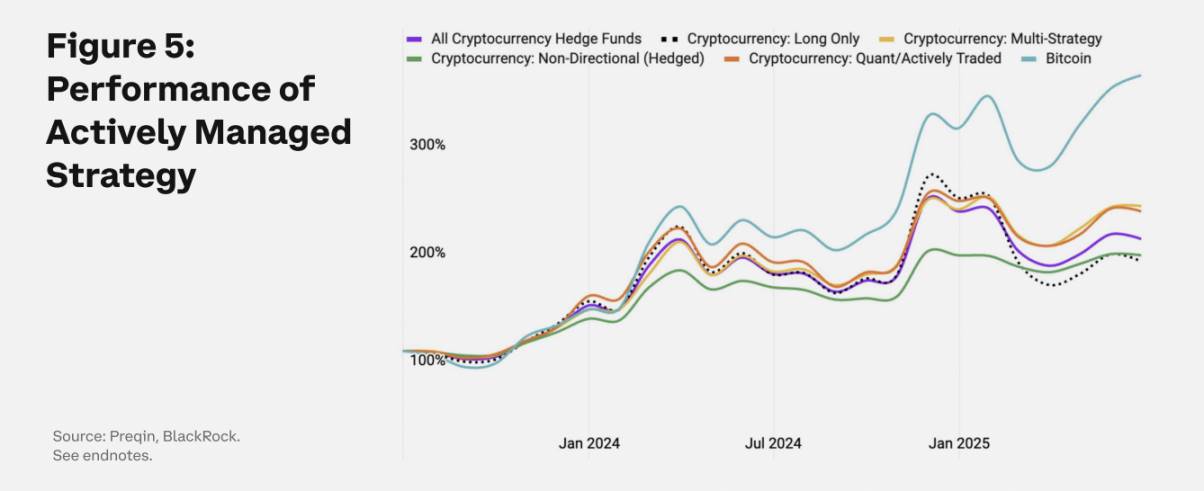
Portfolio D: Store of Value Index = Bitcoin + Gold (10% Allocation)
Is Bitcoin a threat to gold, or a complement to it? Bitcoin has already taken on the role of a store of value. Nearly 300 entities (including state and federal governments, corporations, etc.) have developed Bitcoin reserve strategies, more than double the number from a year ago. However, Bitcoin is not the only store of value asset; it competes with other assets like gold for this status.
With a market cap of $20 trillion for gold and $2 trillion for Bitcoin, we believe that gold and Bitcoin can complement each other. We created an index based on Bitcoin and gold, where Bitcoin's weight is inversely proportional to its volatility. In the current long-term low-volatility environment, Bitcoin's weight in the index will increase.
We view the "Store of Value" index as part of the institutionalization process. This represents the creation of a new asset class, where asset allocators hold both gold and Bitcoin, aimed at addressing the currency devaluation caused by the increasing high government debt in wealthy countries. This differs from the current view that Bitcoin is merely another commodity.
The returns of the portfolio (as shown below) support this view. A 10% allocation to the Store of Value index reflects lower volatility, thereby normalizing the portfolio's volatility during the sample period. In the short term, as the concept of store of value gains widespread recognition among institutions, adding Bitcoin to the portfolio is very beneficial in terms of return contribution and significantly outperforms pure cryptocurrency strategies on a risk-adjusted basis.
However, in the long term, this advantage is not as clear, emphasizing that asset allocators must adopt a dynamic investment approach to value storage assets. A rigorous combination of gold and Bitcoin represents the right allocation at the right time.
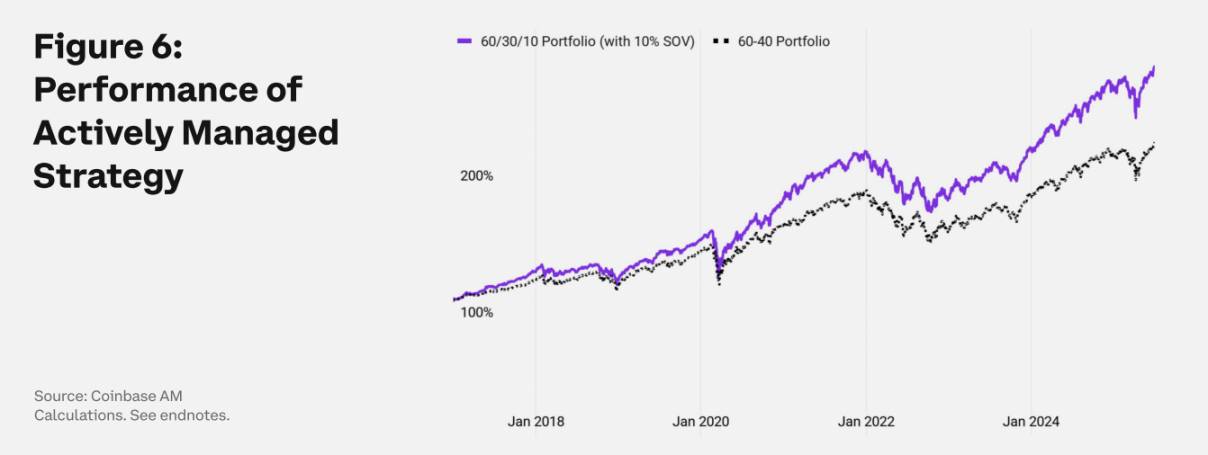
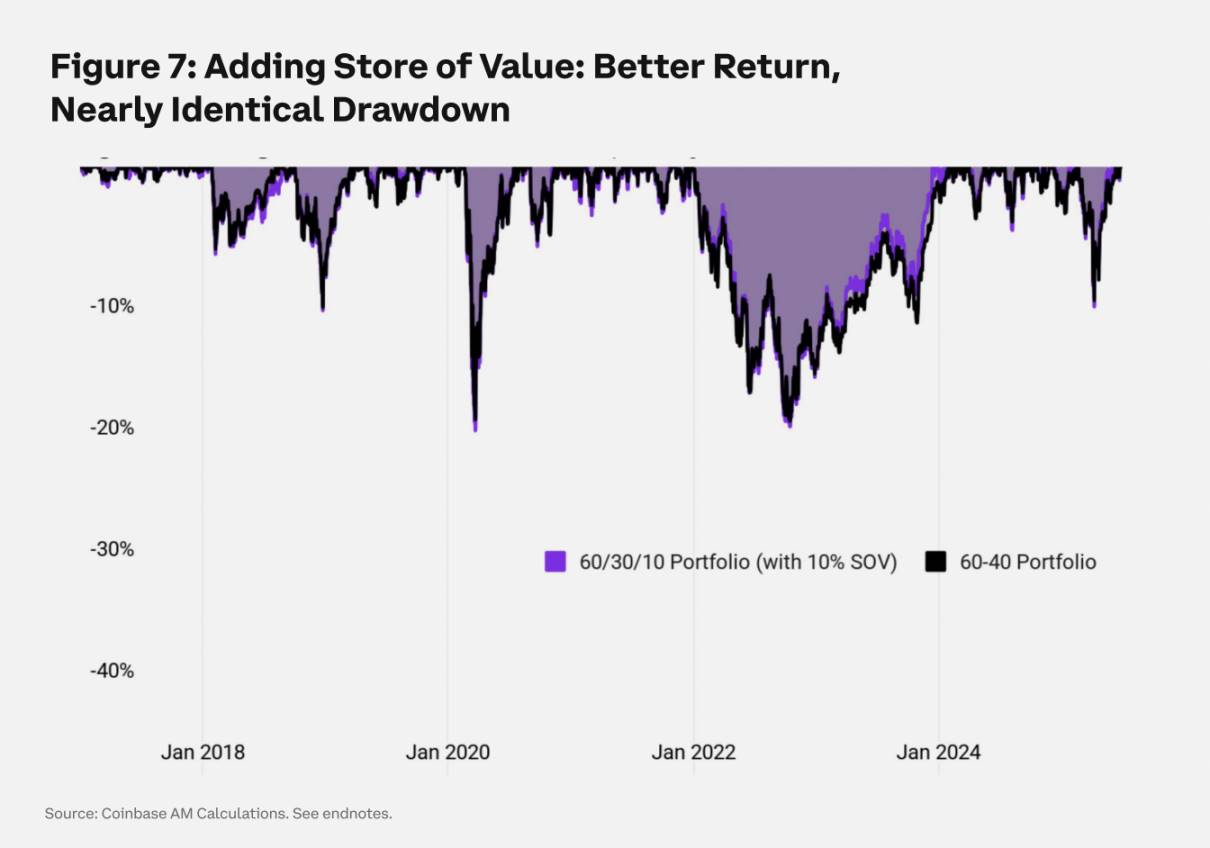
Portfolio E: Cryptocurrency-Related Stocks (10% Allocation)
In our final assessment of breaking free from zero allocation methods, we explored investments in stocks of cryptocurrency-related companies and existing platforms rapidly integrating crypto technology. We created the "MAG7 Crypto Basket," which includes publicly traded stocks from BlackRock, Block Inc., Coinbase, Circle, Marathon, Strategy, and PayPal.
During periods when growth companies outperform the market, we found that incorporating a 10% MAG7 Crypto Basket into the portfolio enhances performance while also increasing volatility. Given the higher volatility of growth stocks, it is not surprising that replacing bonds with crypto stocks would significantly increase the overall portfolio's volatility. The risk-adjusted results lag behind the Store of Value index but are slightly stronger than holding Bitcoin alone. The trade-off is an increase in investment complexity, with the most severe drawdowns. (Performance data can be found in Charts 1 - 3).
Investors seeking to meet specific investment criteria may consider cryptocurrency-related stocks, but this is the most complex and indirect method of investing in crypto assets among the strategies discussed in this article.
Where Do We Go From Here?
How do cryptocurrencies fit into institutional investment frameworks? Addressing this question is crucial for unlocking institutional adoption of crypto assets. This process requires a solid asset allocation framework based on capital market assumptions that shape long-term price expectations and guide portfolio construction.
High stock valuations and ongoing government borrowing have depressed long-term return expectations. According to rigorous capital market assumptions and forward-looking models, the annual return for U.S. stocks is expected to be 7%, and for U.S. bonds, 4%, which is essentially in line with cash returns. In this low-yield environment, investors are compelled to explore innovative capital preservation strategies, with Bitcoin emerging as a prominent choice.
We believe that Bitcoin-led store of value assets deserve a unique capital market category, driven by macro factors such as shifts in monetary policy and inflation hedging. We anticipate an annualized return of 10%, with very low correlation to the bond market, which has seen negligible real returns over the past decade (Chart 8).
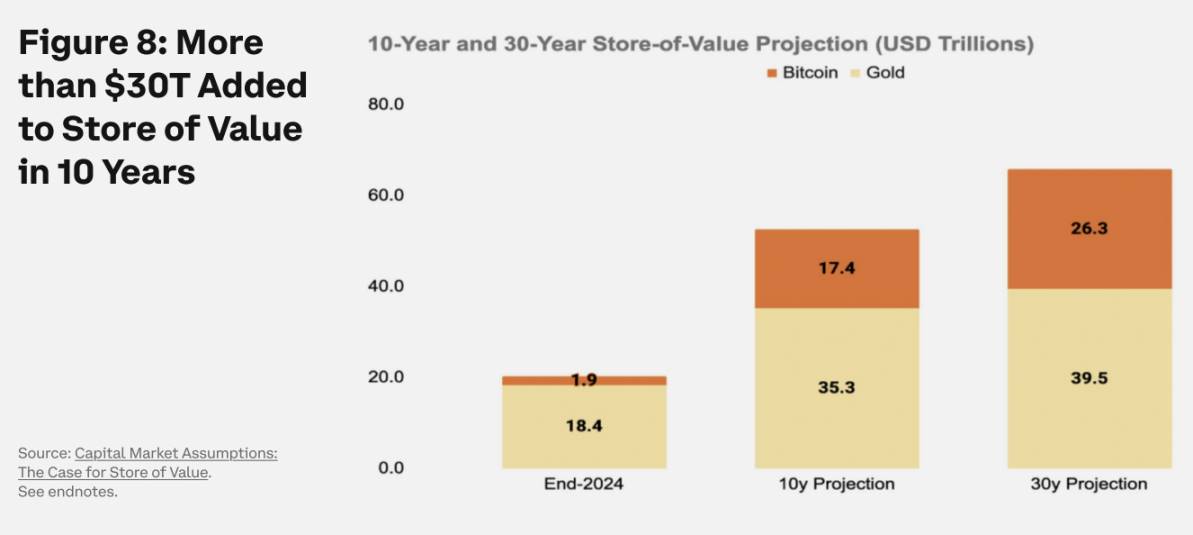
Bitcoin's fixed supply and decentralized nature make it a hedge against high inflation, enhancing the resilience of the portfolio. However, its appeal as a store of value is not just a hedge; allocating Bitcoin can maximize future capital flexibility.
Conclusion
Cryptocurrencies are reshaping the financial landscape. Institutional investors seeking exposure to cryptocurrencies can consider various liquidity market strategies, from direct passive allocations in Bitcoin or the Coinbase 50 index to actively managed funds and strategies that blend traditional finance with crypto finance. Breaking free from zero allocation is often the hardest first step.
免责声明:本文章仅代表作者个人观点,不代表本平台的立场和观点。本文章仅供信息分享,不构成对任何人的任何投资建议。用户与作者之间的任何争议,与本平台无关。如网页中刊载的文章或图片涉及侵权,请提供相关的权利证明和身份证明发送邮件到support@aicoin.com,本平台相关工作人员将会进行核查。




